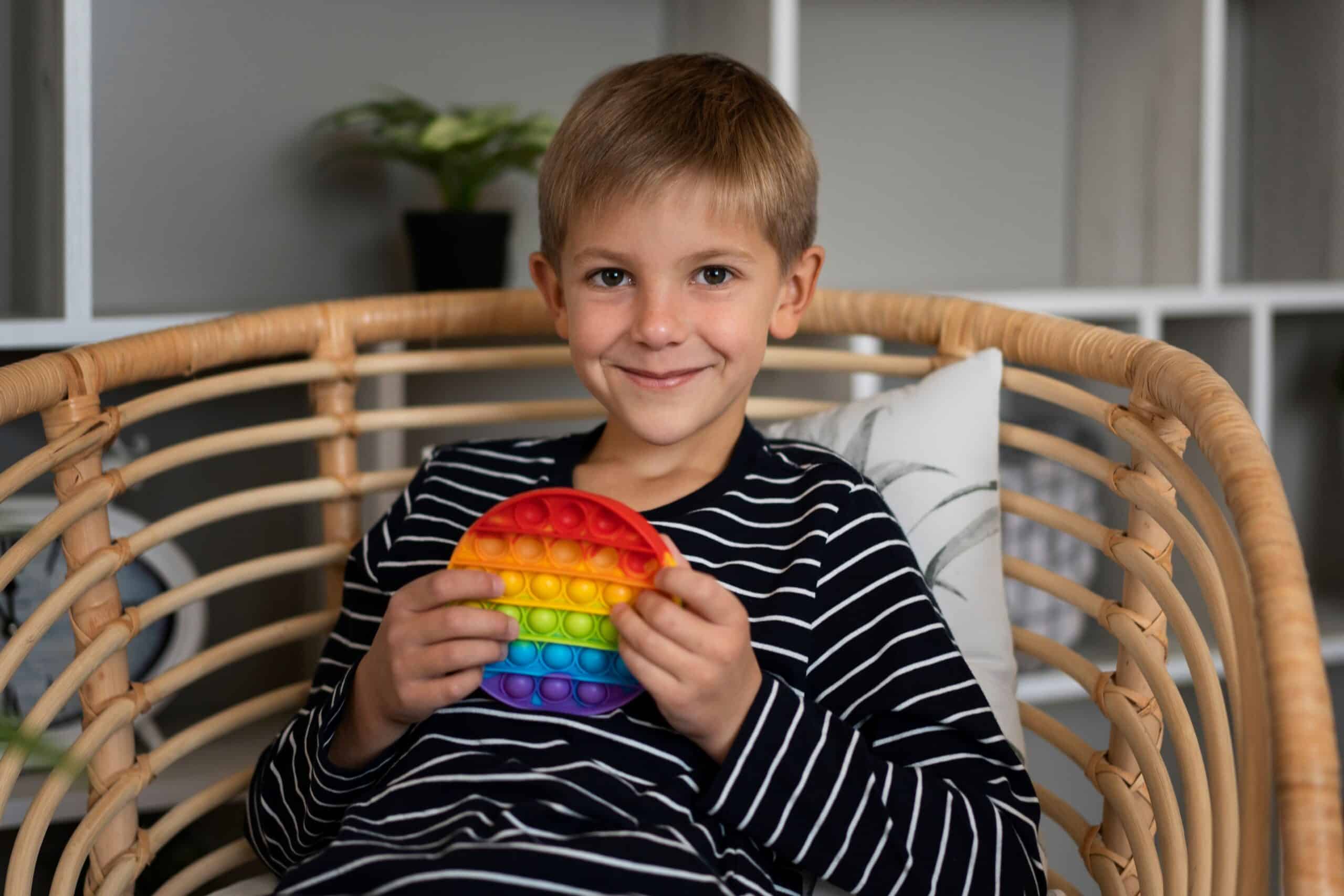It is essential to comprehend the intricate connection, between autism and learning to offer assistance to individuals on the autism spectrum. A significant aspect of how autism affects learning involves variations in how information’s processed.
People with autism might encounter challenges, in sorting and arranging inputs leading to overload or selective focus. This difficulty can make it hard for them to concentrate on tasks or participate actively in classroom exercises. It’s important to note that just as autism varies among individuals, so do the ways in which it affects learning.
For instance, there’s been speculation about various public figures and their potential experiences with autism, including questions like “Is Messi autistic?” This highlights how autism can manifest differently in everyone, including those who may be in the public eye.
Success Stories
“Move Up ABA has been a lifeline for our family. Before starting therapy, our son struggled with daily routines and communication. Now, he’s more independent and even initiated a conversation with a classmate for the first time! The progress we’ve seen in just six months is truly remarkable.”
- Emily R., Silver Spring, Accountant
“As a single dad, I was overwhelmed trying to manage my child’s behavior. The Move Up ABA team not only provided amazing support for my little girl but also taught me practical strategies to use at home. Their in-home sessions fit perfectly with our busy schedule. I’m so grateful for their patience and expertise.”
- Michael T., Rockville, Middle School Teacher
“We were hesitant about starting ABA therapy, but Move Up ABA’s approach put us at ease from day one. Our twins have made incredible strides in their social skills and self-regulation. The therapists are like extended family now, and we couldn’t be happier with our decision to work with them.”
- Aisha and James L., Simpson, Police Officers
Ready to start your child's journey to success? Schedule a free consultation today! 📞 Call (410) 497-8865.
Defining Autism Spectrum Disorder (ASD)

Autism spectrum disorder (ASD) is a condition that impacts how individuals communicate, interact socially, and behave. It presents with a range of symptoms and levels of severity. People with autism may encounter difficulties in communication, both verbal and nonverbal social interactions, repetitive behaviors, and sensory sensitivities.
ASD is a condition that manifests differently in each individual. While some individuals with autism may exhibit talents in certain areas, others may struggle significantly, impacting their learning and overall growth. Understanding the needs of those with autism is crucial for offering support and accommodations throughout their educational journey.
How ASD Influences Cognitive Development and Learning
People with autism may face obstacles in their growth with how they perceive and process information differently. The way information is processed involves how people absorb, arrange, and develope their cognitive understanting of the world around them.
For instance, a person with autism may not be able to interpret the anger from their classmate’s expression, but a neurotypical person knows that furrowed eyebrows and pursed lips equals mad.
This difference in perception results in different reactions. This, in turn, can cause difficulties for those with ASD in areas like attention, memory, problem-solving, and executive functions.
Executive functions encompass a range of abilities that assist individuals in planning, organizing, supervising, and finishing tasks. Challenges with functions can appear as issues with planning, organization, problem-solving, and adaptable thinking.
They might also encounter challenges with cognition. The capacity to grasp and interpret cues, viewpoints and emotions. These obstacles can affect their capability to navigate interactions comprehend standards and expectations while forming meaningful relationships, with peers.
Learning Challenges in Autistic Learners
Autistic individuals who are learning may encounter challenges in aspects, such, as processing information engaging in social interactions and facing academic struggles.
Difficulties with processing involve how those with autism perceive and handle input from their surroundings. This could show up as heightened sensitivity. Decreased sensitivity to stimuli like noises, lights, textures and scents. These sensitivities might affect their ability to concentrate pay attention and participate fully in tasks.
Academic challenges can differ among learners. Might involve difficulties in subjects like reading, writing, mathematics and critical thinking. These struggles could be linked to issues, with processing information, managing tasks effectively. Staying focused.
Difficulties in Social Interaction and Its Effects on Learning
Engaging in interactions requires the capacity to interpret cues recognize body language and participate in meaningful conversations. These abilities play a role, in establishing connections with others working together with colleagues and handling social scenarios.
Autistic individuals may encounter challenges when it comes to interaction such as:
- Finding it hard to grasp and respond to nonverbal signals, like facial expressions and gestures.
- Facing obstacles when starting and sustaining conversations.
- Struggling to comprehend and adhere to societal norms and expectations.
- Having difficulty empathizing with the feelings and viewpoints of others.
Sensory Sensitivities and Classroom Challenges
Individuals, with autism often experience sensitivities, which can significantly impact their classroom experiences. Sensory sensitivities involve heightened or reduced sensitivity to stimuli like sounds, lights, textures and smells.
In settings these sensitivities pose challenges for students. The presence of lights loud noises, strong odors and uncomfortable textures can be overwhelming and disruptive hindering the ability of individuals with autism to focus and engage in learning activities. These sensory issues may result in difficulties with attention span, concentration and overall participation in classroom tasks.
To address these challenges and foster an learning environment teachers can implement the following strategies:
Providing quiet spaces or breaks for individuals requiring regulation of their sensory input.
- Using softer lighting or natural light to minimize visual distractions.
- Reducing noises or offering noise canceling headphones.
- Offering seating options, like flexible seating arrangements or furniture designed for sensory comfort.
Autism and Communication Skills

People, with autism also face difficulties in communicating. These struggles may appear as challenges in developing language, nonverbal interaction and overall communication skills.
Nonetheless, through assistance and interventions, individuals with autism can interact more successfully with others.
Language Development in Autistic Children
Children, with autism may show delays or differences in language development, which can affect their ability to speak understand words and grasp ideas.
Some common signs of language development in children with autism are:
- Speech or unusual speech patterns like repeating words (echolalia) or speaking in a voice.
- Challenges expressing themselves including trouble starting and maintaining conversations, limited vocabulary and difficulty with figurative language.
- Struggles understanding and following instructions or abstract concepts.
- Difficulty using language in social situations recognizing social cues and participating in back and forth conversations.
To help autistic children develop their language skills strategies like:
- Using aids like schedules or cues to aid communication.
- Engaging in activities that focus on improving specific language abilities such as building vocabulary or learning social skills.
- Providing opportunities for interaction and practicing communication skills, in real life settings.
Strategies to Enhance Communication Skills
Here are some ways to help individuals, with autism enhance communication skills:
- Utilizing aids like schedules, stories and cues to aid in understanding and communication.
- Incorporating. Visual tools to assist with comprehension and expression.
- Using language while avoiding unclear ideas.
- Encouraging interaction. Providing real life communication practice opportunities.
- Engaging in language activities that focus on language abilities such as vocabulary enrichment and social skills development.
- Employing AAC devices, for those struggling with speech or expressive language.
- Working closely with speech language pathologists to create communication plans and interventions.
Behavioral Challenges and Educational Settings
In environments individuals, with autism may encounter difficulties due to behavioral issues. These difficulties may encompass actions struggles with adapting to changes, in routines and challenges related to control and emotional management.
Understanding Behavioral Manifestations of Autism
Certain typical signs of autism include:
- Repeated actions, like hand movements, swaying or strong fixations on objects or subjects.
- Struggles with adjusting to changes in schedules or surroundings.
- Issues with controlling impulses and managing emotions resulting in breakdowns or sudden outbursts.
- Sensitivity to stimuli and responses to input, like covering ears or steering clear of specific textures or noises.
- Challenges, in socializing and grasping rules and anticipations.
Positive Behavioral Support and Interventions
Here are some ways and methods that can be utilized in promoting behavior support:
- Clearly outlining expectations and rules while utilizing aids, like schedules or stories to aid in comprehension and cooperation.
- Employing positive reinforcement methods such as verbal praise, incentives or token systems to motivate desired behaviors.
- Applying behavior management strategies like selective ignorance or redirection to manage difficult behaviors effectively.
- Working closely with individuals with autism to create behavior plans tailored to their needs and goals.
- Providing training in skills and techniques to improve interactions and relationships, with peers.
- Offering support and adjustments to address sensitivities and ensure comfort and engagement.
Tailoring Education to Fit the Autistic Learner
It is crucial to customize education to meet the requirements of students, with autism in order to support their learning and holistic growth.
Importance of Individualized Education Programs (IEPs)
Customizing education to cater to the needs of autistic students is essential for fostering their progress and overall development. Tailoring approaches to meet the requirements of students on the autism spectrum ensures their learning and holistic well-being are adequately supported.
Incorporating Visual Aids and Technology in Teaching
Using tools, like aids like schedules, stories, and cues, will help individuals with autism to understand the lessons more easily.
Additionally,, technology like computers, tablets, and interactive software can benefit learners by offering ways to engage with educational content and have a more interactive learning experience.
By setting up an environment that’s visually appealing and interactive individuals, with autism can enhance their skills manage transitions better and follow instructions effectively. This approach also encourages learning and exploration of interests.
Conclusion

Understanding the impact of autism, on learning is crucial in shaping nurturing settings. Autism introduces hurdles in processing information engaging in social interactions communicating effectively and managing behavior all of which can influence the learning process.
By implementing education plans (IEPs) utilizing tools incorporating technology and employing positive behavioral strategies we can greatly enrich the educational journey for students with autism.
At MoveUp ABA located in Baltimore, Maryland our commitment lies in providing personalized support and empowering individuals with autism to thrive. Contact us today to discover more, about our services and how we can support your childs development.
Frequently Asked Questions
What is an Individualized Education Program (IEP)?
An Individualized Education Program (IEP) is a customized plan created for students, with disabilities like autism to define their objectives and the support they require to reach them. It guarantees that their educational setting is customized to suit their requirements.
How can visual aids support learning for autistic individuals?
Visual tools, like timetables and prompt cards offer depictions of information that can improve understanding and alleviate stress. They assist learners with autism in managing schedules and schoolwork efficiently.






